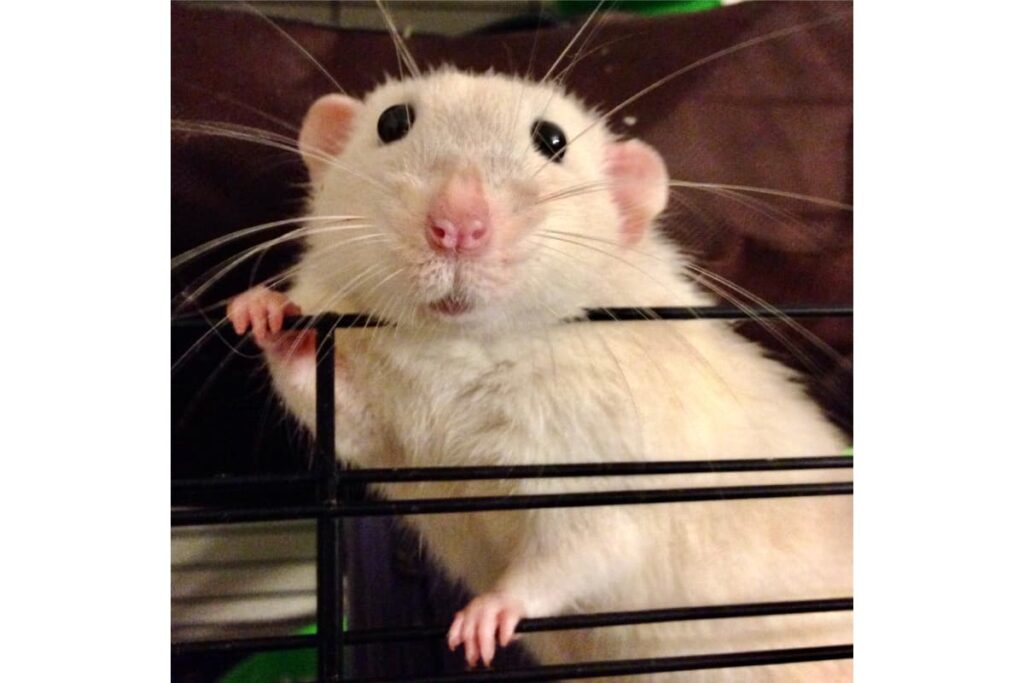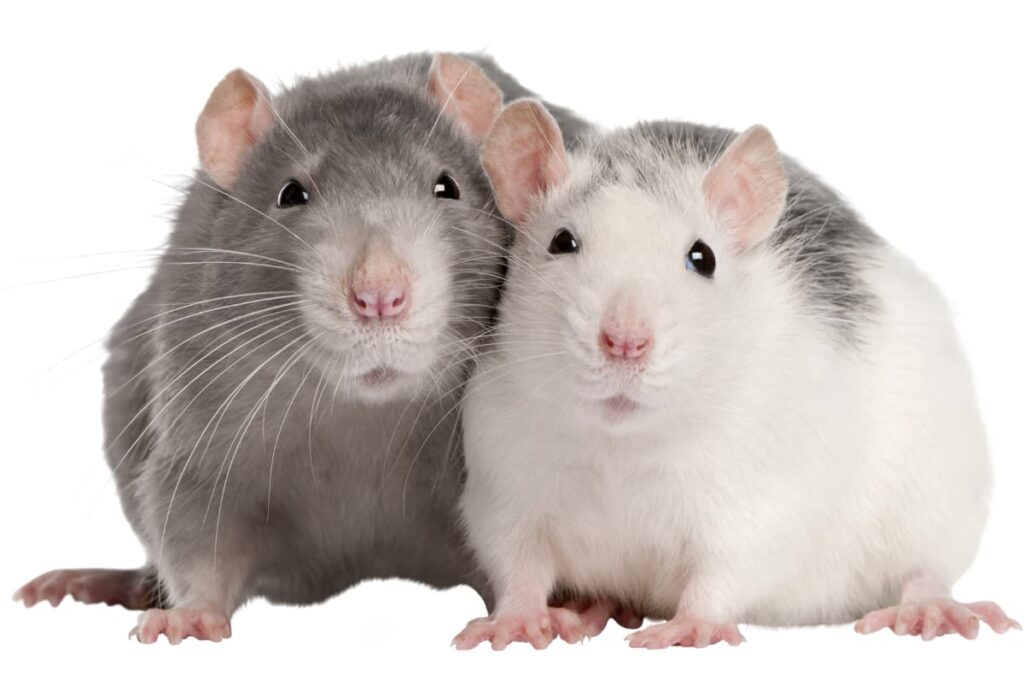Believe it or not, rats have their own way of expressing emotions, including laughter.
That’s right, these little critters can actually laugh, but it’s not quite the same cackle humans emit. Their laughter comes in the form of high-frequency 50-kilohertz ultrasonic calls or “chirps” that are distinct from other vocal emissions in rats, which humans can’t hear without specialized equipment rat laughter.
Rats use these vocalizations to communicate with one another, conveying various emotions such as happiness, pain, and even the feeling of safety. For instance, bruxing – the sound made when rats grind their incisors together, can often indicate a rat feeling truly content and safe, similar to how a cat might purr.
Another fascinating aspect of rat communication is their use of ultrasonic vocalizations during playtime, which can help keep playful actions from escalating into more aggressive ones rat vocalizations.
So, the next time you observe rats interacting, you can appreciate the complexity of their communication and know that when they’re “laughing,” they’re expressing various emotions and navigating their social world just like you do in your day-to-day life.
The Basics of Rat Communication
Types of Vocalizations
Rat vocalizations can convey different emotions, such as happiness, pain, or fear. Some rats are more audibly “talkative” than others, and their vocalizations can range from chatters, squeaks, to hisses that you can hear.
Ultrasonic Vocalizations
Rats primarily communicate through ultrasonic vocalizations, which are sounds at frequencies above what your ears can hear.
They use these sounds to express emotions, deter playful actions from escalating into aggressive ones, or even for life-preserving purposes like avoiding predators.
Body Language
Aside from vocalizations, rats also rely heavily on body language to communicate.
You can observe their behavior and notice certain postures or movements that can give you an idea of what they’re feeling or trying to convey. For example:
- A rat standing on its hind legs with its ears forward may signify curiosity.
- A rat with its back arched, fur bristling, and ears flattened could indicate it feels threatened.
- If you see your rat grooming itself or another rat, it’s a sign of social bonding and relaxation.
Pheromones
Rats communicate through pheromones as well, which are chemical signals that they release from their body. These chemicals can serve different purposes, such as marking their territory or signaling reproductive status to attract mates.
Rats can detect these pheromones through their sense of smell, and it helps them navigate their social and physical environments.
Understanding Rat Laughter

Tickling and Laughter
You might be surprised to learn that rats are able to laugh.
When rats are tickled, they produce ultrasonic vocalizations (USVs) at a frequency at or above 50 kilohertz, which is above the range of human hearing.
This “laughter” can be recorded and analyzed using specialized equipment 1. Rats’ laughter sounds different from ours and even varies among individuals within the species 2.
Rats as Pets: Can You Tickle Your Pet Rat?
Considering the findings about rat laughter, you might wonder if you can engage your pet rat in a tickling session to evoke these ultrasonic giggles.
While tickling rats is generally perceived as positive for them, it’s important to remember that the experience may vary between individual rats. Some rats may enjoy the interaction, while others may not respond as positively.
I wouldn’t advise tickling a strange rat. Unless the rat is your best friend you may want to skip trying to give it a tickle. Tickling a strange rat might just get it pissed off, in which case it won’t be laughing (and you could end up crying from close contact with rat incisors).
Emotional States
Rats, like humans and other animals, experience various emotional states that can be observed through their behaviors and reactions.
One method of understanding these states is evaluating their response to tickling. When rats are tickled, researchers believe that they experience a positive emotional state similar to joy, affection, or amusement 3.
Understanding these emotional states in rats can lead to discoveries about their cognitive abilities and evolutionary connections to human emotions.
Neural Mechanisms
The neural mechanisms underlying rat laughter are complex and involve several regions of the brain.
The somatosensory cortex, for example, plays a role in processing tickling sensations and generating laughter. The neurons in this region respond to the physical stimulation and communicate with other brain areas that interpret and produce the laughter-like response 4.
As research continues to uncover the neural basis of rat laughter, it may provide valuable insights into the emotional lives of animals and potential/interesting applications in behavior management.
The Role of Ultrasonic Vocalizations in Social Interactions
Rats use ultrasonic vocalizations (USVs) as a form of communication in various social situations.
In this section, you’ll learn about the role of USVs in social interactions, specifically in the contexts of social play, mating and bonding, and predator and fear responses.
Social Play
During social interactions, juvenile and adult rats emit 50 kHz ultrasonic vocalizations. These play-induced USVs are thought to be an expression of positive affective states, similar to laughter in humans.
As rats engage in rough-and-tumble play, they use these vocalizations to communicate excitement and enjoyment. However, research shows that vocalizing rats do not perform or receive more interactions compared to devocalized rats, suggesting that these USVs may not significantly modulate social behavior during play.
Mating and Bonding

USVs play an essential role in mating and bonding behaviors among rats. They help to strengthen social bonds and navigate various aspects of mating dynamics.
While specific details on USVs in rat mating are limited, it is known that rats’ vocalizations are involved in affiliative behaviors, leading to approaching and staying in close social groups.
Predator and Fear Responses
Rats also use USVs in response to potential threats, such as the presence of predators or fear-inducing situations. Juvenile and adult rats emit 22-kHz USVs in aversive situations, including social defeat.
These lower-frequency vocalizations may alert conspecifics (members of the same species) to potential danger, and possibly function as a signal to inhibit social exploration or interactions with unfamiliar individuals.
Comparing Rat Laughter to Other Species
In this section, you’ll explore how rat laughter compares to laughter-like behaviors in other species, such as apes, primates, dogs, and other mammals.
Apes and Primates
When observing laughter in apes, you might notice many similarities with human laughter. Chimpanzees, gorillas, and bonobos are known to display laughter-like vocalizations in response to tickling or playful behavior. Orangutans also exhibit vocalizations that resemble laughter, which can be observed during play, grooming, or social interactions.
While rat laughter is characterized by high-frequency ultrasonic vocalizations or chirps, the laughter of apes and primates is typically within the range of human hearing.
Dogs and Other Mammals
Dogs might not laugh in the same way humans or apes do, but they exhibit a behavior called play-panting, which some researchers argue is a form of laughter. This panting often occurs during playtime and social interactions, and serves as a signal of enjoyment and invitation to other dogs to join in the fun.
Other mammals, such as foxes, lambs, and guinea pigs, exhibit a behavior called joy jumps, characterized by leaping into the air with both legs together, a classic expression of positive emotion.
While exploring these laughter-like behaviors, keep in mind that each species has unique ways of expressing joy and other emotions. In the context of rat communication, understanding these differences and similarities will offer valuable insights into their emotional responses and behaviors.
See my articles on some amazing communication in other species:
- Why Wolves Howl (Wolf Communication Explained – Listen to Wolves Howling)
- How Do Whales Communicate and Make Sounds Under Water? Latest Science
- What Sounds Does a Fox Make? A Guide to Fox Vocalizations
- Octopus Camouflage Uncovered: The Science Behind Their Smart Skin
Research on Rat Communication and Laughter
Methods and Techniques
To study rat communication and laughter, researchers use a combination of approaches.
One of the pioneers in this field, Jaak Panksepp, discovered that when rats are tickled, they emit ultrasonic vocalizations (USV) at 50 kilohertz. These sounds, which are above the range of human hearing, can be heard using special ultrasound equipment.
By recording these USVs and visualizing them on a sonograph, scientists can analyze the sounds and their potential meanings.
To better understand the context of these vocalizations, researchers also observe rats’ behavior during various activities, such as play, approach behavior, and social interactions with other rats. They may use marking techniques to identify individual rats and track their behaviors and responses over time.
This combination of behavioral observations and sound analysis allows for a more comprehensive understanding of rat communication.
Notable Findings
Some key findings from research on rat laughter and communication include:
- Rats emit 50 kHz ultrasonic vocalizations during social play, which is thought to be an expression of positive affect, similar to laughter in humans.
- These vocalizations can also function as communication signals between rats, especially during playtime or when anticipating rewards.
- In anxious situations or when rats encounter new environments or animals, they may also emit these 50 kHz USVs, which has been likened to nervous laughter in humans.
- Rats’ vocalizations decrease with age, becoming less frequent as they grow older.
Overall, these findings shed light on the complex communication systems of rats, which share some similarities with those of humans and other animals.
As research on rat laughter continues, it is fascinating to see how these small rodents can provide valuable insights into the emotional and social lives of all species, including our own.
Implications and Applications

Human-Rat Interaction and Empathy
Understanding rat communication, particularly their 50 kHz ultrasonic vocalizations (USV), can greatly enhance your bond with your pet rat through improved interaction.
By decoding their body language and actions, you can better respond to their needs and emotions.
Learning about the similarities between young rats and children in expressing joy during play contributes to establishing empathy between humans and rats.
Just like children, laughing rats (PDF) vocalize their happiness through play, which, for rats, includes wrestling and chirping. Recognizing this, you’ll be more inclined to treat your pet rat with kindness and understanding.
Animal Welfare Considerations
Being aware of the way rats communicate their emotions, especially in relation to pleasure and pain, can help you and other researchers ensure their well-being.
Identifying their ultrasonic calls and behavioral patterns can help you differentiate between play and distress in situations involving pups or orphans.
For instance, understanding the evolutionary relationship between morphine-induced vocalizations and pain responses can lead to better approaches in alleviating pain or distress in rats.
Not only can this improve overall quality of life for your pet rat but also strengthen the ethical treatment of animals in research and welfare-related situations.

